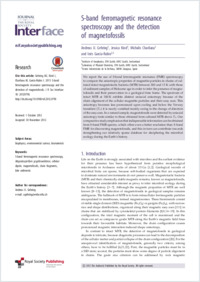S-band ferromagnetic resonance spectroscopy and the detection of magnetofossils.
- Gehring AU Institute of Geophysics, ETH Zurich, , 8092 Zurich, Switzerland. agehring@erdw.ethz.ch
- Kind J
- Charilaou M
- García-Rubio I
- 2012-12-28
Published in:
- Journal of the Royal Society, Interface. - 2013
English
We report the use of S-band ferromagnetic resonance (FMR) spectroscopy to compare the anisotropic properties of magnetite particles in chains of cultured intact magnetotactic bacteria (MTB) between 300 and 15 K with those of sediment samples of Holocene age in order to infer the presence of magnetofossils and their preservation in a geological time frame. The spectrum of intact MTB at 300 K exhibits distinct uniaxial anisotropy because of the chain alignment of the cellular magnetite particles and their easy axes. This anisotropy becomes less pronounced upon cooling and below the Verwey transition (T(V)) it is nearly vanished mainly owing to the change of direction of the easy axes. In a natural sample, magnetofossils were detected by uniaxial anisotropy traits similar to those obtained from cultured MTB above T(V). Our comparative study emphasizes that indispensable information can be obtained from S-band FMR spectra, which offers even a better resolution than X-band FMR for discovering magnetofossils, and this in turn can contribute towards strengthening our relatively sparse database for deciphering the microbial ecology during the Earth's history.
- Language
-
- English
- Open access status
- bronze
- Identifiers
-
- DOI 10.1098/rsif.2012.0790
- PMID 23269847
- Persistent URL
- https://folia.unifr.ch/global/documents/202938
Statistics
Document views: 15
File downloads:
- fulltext.pdf: 0
